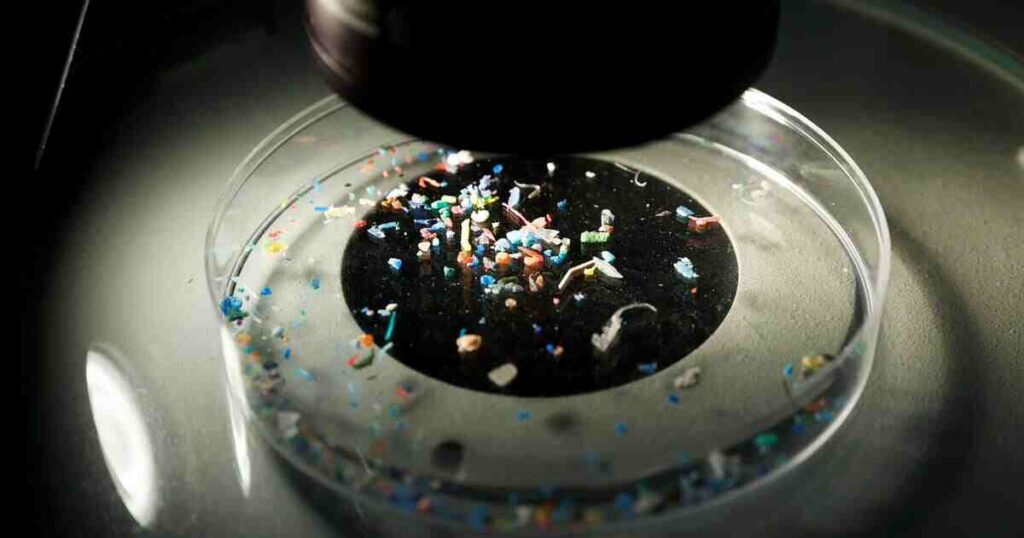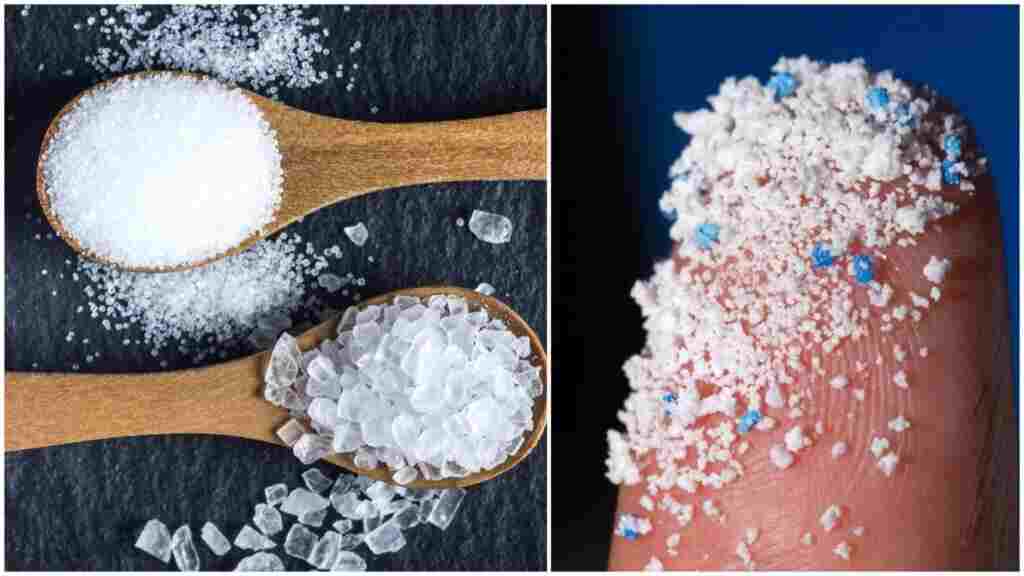Introduction
A recent study published by the environmental research group Toxics Link has found that all Indian brands of salt and sugar, regardless of their size or whether they are packaged, contain microplastics. The study, “Microplastics in Salt and Sugar,” analyzed various types of salt, such as table, rock, sea, and local raw salt, and five varieties of sugar obtained from online and local sources.
Exposure to microplastics or nanoplastics is emerging as a major global concern as it adversely impacts health and the environment. This article explores how microplastics are infiltrating salt and sugar, what current research reveals about their impact, and what this means for our health and well-being.
Understanding the Controversy
The environmental research organization “Toxics Link” said that a test carried out on 10 types of salt and five types of sugar, purchased from online and local markets, showed the presence of microplastics in all samples. The size of these microplastics ranged from 0.1 millimeter to 5 mm and were found in various forms such as fiber, pellets, films, etc.
According to the report, the highest quantity of microplastics was found in iodized salt at 89.15 pieces per kilogram. Overall, the quantity ranged from 6.71 to 89.15 pieces per kg of dry weight in the salt samples. Organic rock salt had the lowest quantity at 6.70 pieces per kg. In sugar samples, the microplastics ranged from 11.85 to 68.25 pieces per kg with non-organic sugar reporting the highest levels.
A PTI report cited past studies to say that Indians on average consume 10.98 grams of salt and around 10 spoons of sugar every day. This is much greater than the official recommended levels.
Ravi Agarwal, founder and Director, of Toxics Link said, “The objective of our study was to add to the existing scientific database on microplastics so that the global plastic treaty addresses this issue in a concrete and focused manner. The aim is also to trigger policy action and attract the attention of researchers for possible technological interventions to reduce the exposure risks to microplastics.”
Satish Sinha, associate director at Toxics Link, expressed concern over the findings, emphasizing the necessity for extensive research into the long-term health effects of microplastics on humans. According to the study, the number of microplastics found in salt samples varied widely, with iodized salt containing the highest level at 89.15 pieces per kilogram and organic rock salt the lowest at 6.70 pieces per kilogram.

What are Microplastics
Microplastics (MPs) are defined as plastic particles that have a size range of less than 5 mm down to 1 µm.5 MPs are classified into primary and secondary categories, based on their origin. Primary MPs refer to plastic particles that are intentionally manufactured and released into the environment in their original form, while secondary MPs are generated by the process of degradation and fragmentation of larger plastic materials due to mechanical fragmentation, photolytic, and biological degradation.
Microplastics, defined as minute plastic particles, have evolved into a global concern due to their potential adverse impact on health and the environment. Studies have shown the presence of microplastics in water, soil, air, and even biota, indicating their ubiquity. In recent years, microplastics have also appeared as an emerging food contaminant, raising concerns about their occurrence in diverse food items such as seafood, drinking water, beverages, and honey.
According to a scientific journal publication titled, ‘Microplastics in the Northwestern Pacific’, microplastics make their way into the human bloodstream directly through products that consist of them. At a cellular level, microplastics’ potential impacts include permanent alterations to cell structures, mutations, and chronic toxicity.
Microplastics in Food
Microplastics have become so ubiquitous that they have been now detected in food items as well. Though early studies focused on the presence of microplastics in seafood because of huge marine pollution, recent studies have highlighted its presence in fruits, vegetables, and many packaged food items. Food consumption is considered one of the most important routes of human exposure to micro and nanoplastics.
Fruits and vegetables
Testing of fruits and vegetables for MPs has been recent, hence there are limited studies. Micro and nanoplastics were detected in fruits apples, European pears, and vegetables broccoli, lettuce, carrot, and potato collected from Catania markets in Italy in 2020. MPs were also detected in fresh fruits (pear, apple, tomato) and vegetables (onion, potato, cucumber) collected from Turkish markets in 2023
Beverages and daily drinks
Microplastics were also detected in various beverage samples, including soft drinks, energy drinks, and cold tea. A study conducted in Mexico City in 2020 analyzed 57 samples from supermarkets and identified MPs in 48 of them. The types of MPs identified include PA, poly(ester-amide), PET, and acrylonitrile butadiene. A study carried out in Italy identified higher levels of MPs ranging from 2,563 to 5,857 MPs/L in white wine.
Drinking water
Apart from food, MPs have also been found in drinking water. A recent study in 2024 found the occurrence of MPs in national and local bottled water brands procured from the market of Nagpur, India.28 A study done by Toxics Link in 2021 detected the presence of MPs in 11 tap water samples collected from Goa, India. The study showed 288 Microplastics in the samples with 26 different polymer types.

Meat
In 2020, a study detected Microplastics in poultry meat as a part of the OceanWise Project, which aimed to develop a long-term measure to mitigate the impact of expanded and extruded PS products in the North-East Atlantic Ocean. The study asserted the presence 7 of MPs on the surface of the meat products, emphasizing the potential to enter the human body through consumption of meat/meat products
Microplastics in Salt and Sugar
Apart from fruits, vegetables, beverages, and water, MPs have been also detected in salt and sugar. Salt is the most widely consumed food item and is vital for human processes as it maintains sodium and chlorine levels in the body. Sugar is a source of carbohydrates and is also considered an essential food item for the human body.
The presence of MPs in salt and sugar raises concerns about the potential impact on human health. Although, currently, there is limited knowledge of the health effects of microplastics, several studies have suggested that MPs can pose a risk to human health. Plastic products, and consequently the MPs degraded from them, are complex chemical mixtures containing multiple additives.
Potential Impact of Microplastics in Salt and Sugar on Human Health
On average, an Indian consumes 10.98 grams of salt per day, which is more than double the World Health Organization’s recommended limit of 5 grams per day. With the per capita consumption of sugar of approximately 10 spoons per day, the average Indian eats almost 18 kg of sugar per year. Since humans consume food products containing salt and sugar throughout their lives, the intake of microplastic is also expected to be substantial.
Microplastics have been detected in various human body parts such as head hair, saliva, sputum, bronchoalveolar lavage fluid, lungs, liver, breast milk, placenta, infant, feces, spleen, kidney, colon, blood, and semen samples. Microplastics can enter the human body via three primary routes: ingestion; inhalation and direct skin contact. In all living organisms, exposure to MPs can lead to harmful effects, inflammation, and increased absorption or movement of these particles. MPs are distributed in different tissues and organs depending on their sizes.
Consumption of microplastics in childhood can lead to impaired cognitive problems, brain development, and neurotoxicities. In the early stages of growth, the immune system is being developed and excessive consumption of microplastics can lead to various health diseases such as ADHD, behavioral and development problems, and endocrine disruption. In the case of pregnant women, there can be chances of growth impairment of the fetus developing inside the womb as microplastic particles can get stuck inside the placenta.
Regulation and Mitigation Strategies
Currently, there is no regulatory framework to monitor the presence of MPs in food products, including salt and sugar. However, several countries have initiated studies and monitoring programs to assess the extent of microplastic contamination in food and to develop potential mitigation strategies.
In terms of mitigation strategies, several methods have been proposed to reduce microplastic contamination in food production and processing. These include improving wastewater treatment to prevent MP release, implementing best practices for plastic waste management, and developing alternative materials to replace plastics in food packaging and processing.
Conclusion
The presence of microplastics in salt and sugar highlights an urgent environmental and public health issue. As these tiny particles pervade our food supply, the long-term implications for human health remain largely unknown, warranting further research. Meanwhile, addressing plastic pollution at its source, along with increasing public awareness and pushing for stricter regulations, is crucial to mitigating the risks. Consumers, industries, and policymakers need to collaborate in reducing plastic waste to ensure the safety of our food and overall well-being.
-BHAWNA SINGH
Must Read:77 YEARS OF INDEPENDENCE- INDIAN WOMEN’S SILENT TORTURE ENDURANCE AND THE SOCIETAL CAGE


